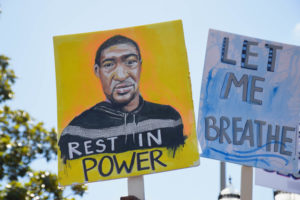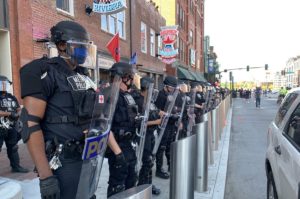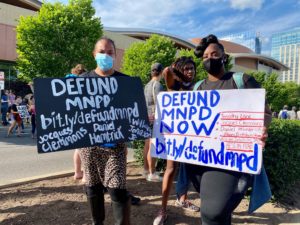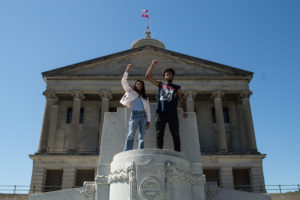
Samantha Max, Ambriehl Crutchfield and Paige Pfleger contributed to this reporting.
The murder of George Floyd forced the country to reckon with its racist history and modern systems that uphold white supremacy.
In Tennessee, thousands took to the streets to call for change — big change — to the way we think about public safety, to the resources that go into local police departments, and to the monuments we put in places of public prominence.
One year later, WPLN News is checking up on the demands protesters voiced and how the local and state governments have reacted.
Police reform
Some of the loudest calls for change targeted how police interact with community members, and increasing accountability for those who don’t follow protocols. Many advocated for police to institute policy changes from a national campaign called “8 Can’t Wait.” In Nashville, most of those policies were already on the books, but Metro Nashville Community Oversight recommended three ways to tighten up policies and close loopholes.
Banning chokeholds and neck restraints
 Rachel Iacovone WPLN News (file)
Rachel Iacovone WPLN News (file)In the year since George Floyd’s murder MNPD has explicitly banned the use of chokeholds and neck restraints.
Neck restraints were not taught to Nashville officers before the protest movement last summer, but also weren’t explicitly prohibited. In July 2020, the Metro Nashville Police Department explicitly banned the use of neck restraints. The Tennessee legislature did the same with HB1406/SB1380, though it allows officers to use chokeholds if they “reasonably [believe] that deadly force is authorized.” The new law also prohibits judges from issuing no-knock warrants. That’s the kind of warrant that Louisville police used to forcibly enter Breonna Taylor’s apartment looking for a man who was not there, and where they fatally shot her.
Requiring de-escalation
While MNPD says that de-escalation is a “fundamental element” of its training and policies, the Community Oversight Board recommended adding language that specifically requires officers to use de-escalation tactics before using physical force. The department has not added that language.
MNPD did institute a duty to intervene if one officer sees another using excessive force or abusing their authority. That policy was enacted shortly after protests began in June of last year.
Prohibiting shooting at moving vehicles
Metro Police currently prohibits officers from shooting at moving vehicles “unless absolutely necessary to protect the life of the employee or others.” It also bars officers from stepping into the path of a moving vehicle.
However, Metro Nashville Community Oversight recommended in its policy review that MNPD only allow shooting at a moving vehicle when an occupant is using deadly force other than the vehicle itself. The board also recommended specifying that remaining in or moving into the path of a vehicle would not be grounds for opening fire.
MNPD has not changed this policy.
HB1406/SB1380, which was signed into Tennessee law earlier this month, does require departments across the state to shape their own policies regarding shooting at moving vehicles by the start of next year. But it too allows departments to permit shooting at moving cars and motorcycles if the officer thinks deadly force is authorized.
Demilitarizing police
 Blake Farmer WPLN News (File)
Blake Farmer WPLN News (File)Police stand in riot shields outside of the Lower Broadway honky tonks during protests against racial injustice in summer 2020.
MNPD has made no efforts to reduce the number or kinds of military-style equipment used by the department. The department has an armored vehicle as well as rescue boats and a helicopter that uses military parts.
It is looking at some changes to its equipment though. MNPD announced that it’s in the process of upgrading its Taser devices so that they are more visually distinct from guns and more effective. The Metro Police commander who oversees the academy says the improved equipment could help de-escalate situations without deadly force.
Better relations with COB
MNPD Chief John Drake vowed when he was appointed to foster a better relationship with the Community Oversight Board. Since then, the department has entered into a memorandum of understanding with the oversight board, agreeing to communicate more frequently and meet at least once a quarter to discuss challenges and opportunities for improvement. The MOU also gives the board the right to investigate allegations of police misconduct and promises access to crime scenes, documents, information and witnesses “to the maximum extent legally permissible.”
Defunding the police
During protests against police brutality, many called for defunding the police. Interpretations about what that looks like vary. But most involve some combination of reducing funding for police departments over time and reinvesting that money into resources that promote public safety by other means, like expanding resources that help communities thrive. Some demonstrators did call for outright abolition of the police and a reimagining of what public safety looks like.
Reducing budget allocation
Despite calls last year to reduce funding for the police department, Nashville gave a modest increase to MNPD’s budget, though not as large as in other recent years. The Nashville People’s Budget Coalition, a group that pushed for defunding, released a statement saying they were “disgusted and enraged” by that decision.
 Samantha Max WPLN News
Samantha Max WPLN NewsJason Casale says he would like to see money spent on training and equipping police officers to be reallocated to education and public health.
Part of the budget increase went toward purchasing body cameras for every officer in the department. Those are still in the process of being rolled out. There were hopes from both the department and community members that body cameras would increase transparency and accountability. However, the process of releasing footage in some recent police shootings has been inconsistent, and some of the videos have been edited and voiced over with the department’s narrative of events.
This year’s police department budget is still being hammered out, but Mayor John Cooper’s proposal calls for an increase that’s even larger than last year’s. His spending plan would open and staff a new precinct in Southeast Nashville, one of the most diverse parts of the city. Councilmembers say their constituents in the area have asked for this.
More: State Of Nashville: Mayor Wants To Boost Schools And Housing, But Equity Questions Persist
The People’s Budget Coalition says this year’s proposed budget again fails Black Nashvillians, pointing to the funding bump for police and additional dollars for incarceration. They say any increase in funding is misdirected and should go toward non-police resources.
Shifting tax dollars to policing alternatives, mental health support, and crisis response
Cooper has also announced $1 million for behavioral health counseling and a crisis response team. That would have trained clinicians responding to calls alongside officers in the hopes of de-escalating mental health crises. MNPD’s training commander tells WPLN News the department isn’t yet sure which party will take the lead on calls, and that it will likely depend on the circumstances.
$2 million in grants will fund community safety strategies. In the last year, the city has also created an Office of Alternative Policing, and hired Ron Johnson to be the first community safety coordinator within the mayor’s office.
Spending more on community resources
Mayor Cooper’s recent spending proposal would mean more spending on the types of resources protesters pushed for last summer. It includes significant pay increases for teachers and fully funding the school system’s requested budget. It increases funding for the Office of Family Safety and plans to roughly triple the city’s spending on affordable housing.
 Samantha Max WPLN News (File)
Samantha Max WPLN News (File)Another component of defunding the police is investing that money into resources that help communities thrive.
It invests in the historically under-funded and over-policed neighborhood of North Nashville, creating a new public transportation hub. It also calls for building a land bridge over Interstate 40, which leveled homes, disrupted businesses and isolated the majority-Black area from the rest of the city decades ago.
The proposed budget also includes $2 million for infrastructure upgrades in the 37208 ZIP code in North Nashville. The specific projects will be determined by members of the community in what’s known as “participatory budgeting,” with the goal of giving residents a direct say in how their neighborhood grows.
$49 million in funding — more than recent years — is being earmarked for Metro General Hospital, which serves many uninsured patients.
These plans would represent a notable response to demands made last summer. The Metro Council will have the final say when the budget is finalized in June.
Public spaces and symbols
Another call heard across the nation during protests for racial justice was the removal of monuments honoring the Confederacy. In Tennessee, many people of color said that seeing Confederates honored in places of public importance made them feel unsafe. They advocated for removing the statues and, in some cases, moving them to museums, where their history can be unpacked and contextualized.
Removing the bust of Nathan Bedford Forrest and other Confederate monuments
 Chas Sisk WPLN News
Chas Sisk WPLN NewsA bust of Nathan Bedford Forrest has stood in the Tennessee State Capitol since 1978. Two government bodies have approved its relocation to the Tennessee State Museum.
After immense pressure last summer, Gov. Bill Lee endorsed the removal of a bust of Nathan Bedford Forrest from the state Capitol building. Forrest was an early leader of the Ku Klux Klan and a Confederate general. His likeness was installed in the Capitol after the passage of the Civil Rights Act and the assassination of Dr. Martin Luther King Jr. People have long called for the bust to be removed, but it reached a fever pitch last year, when a group of protesters occupied plaza spaces at the state capitol.
The Capitol Commission voted in July to petition the Tennessee Historical Commission to move the bust of Forrest and two other military figures to the state museum. The Historical Commission approved that move earlier this year. Still, leaders of Tennessee’s legislature claim yet another body must approve Forrest’s removal (though an opinion they sought from the state’s attorney general says that’s up for debate.) Lt. Gov. Randy McNally says he expects the Building Commission to take up the issue this summer, though the Tennessean reports the final decision is unlikely to change.
At present, Forrest’s bust remains in the legislative center of the state. It will stay there until at least July, when the historical Commission’s mandatory waiting period expires, but possibly longer.
Replacing Carmack statue with another figure
 Paige Pfleger WPLN News
Paige Pfleger WPLN NewsPeople’s Plaza protesters stand on the pedestal that once held a statue of Edward Carmack.
Protesters toppled a statue of Edward Carmack last year, who was a divisive politician and newspaper editor in the early 1900s. When three Black grocery store owners in Memphis were arrested and lynched, Ida B. Wells, a Black journalist and editor of an African American paper in the city, denounced the violence. In response, Carmack published writings in his paper that incited a mob against Wells, which destroyed her offices. One historian with the state museum says she never returned to Memphis.
Questions remain about what will happen next with the Carmack statue, which has spent most of the last year damaged and untouched in a loading dock. Demonstrators say they want the statue to be replaced with somebody who’s more representative of Tennesseans than the segregationist senator, and have floated Wells’s name. But they say their focus is better placed on diversifying the makeup of lawmakers inside the capitol than the statues placed around it.
Meanwhile, state legislators voted to erect a statue of frontiersman Davy Crockett. That wouldn’t address the lack of diversity, and it’s unclear where that statue will go.
Meeting with Gov. Bill Lee
Finally, protesters with the People’s Plaza group occupied grounds around the state capitol for 62 days, according to their website. Throughout that time, they asked for the defunding and demilitarization of police, and the removal of Confederate monuments. They had one additional request: to meet with Gov. Bill Lee.
During that time, dozens of demonstrators were arrested. Many pitched tents and stayed in the summer heat for hours to pressure the governor to meet and talk about their concerns. That meeting never happened.
 Samantha Max WPLN News
Samantha Max WPLN NewsThe bill Gov. Bill Lee signed into law made unauthorized camping a felony, carrying up to 6 years in prison and the loss of voting rights.
Instead, Lee called a special session of the legislature, where lawmakers passed a bill that made unauthorized camping on state property — such as the plaza protesters had occupied — a felony, meaning violators would lose their voting rights and face up to 6 years in prison. Lee signed that bill into law.
A similar bill introduced this year would have made it a felony to demonstrate in roadways and offered some immunity to drivers who hit protesters with their cars. It was sent to summer study, killing it for the most recent session.
As for People’s Plaza demonstrators who were arrested last year, most of their charges have been dropped or retired. However, a few still face hearings. That includes activist Justin Jones, whose charges have been pushed to July.

